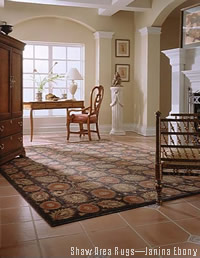|
Area Rugs
 The fastest way to change a mood or character of a room is to add an area rug. Using the appropriate pad, area rugs can go on top of any kind of flooring, usually with dramatic results.
Area rugs can be very inexpensive or phenomenally expensive depending on the material used, how they were made and the degree of artistry or intricacy in their design. Handmade wool, 100% silk or wool and silk Oriental or Persian rugs have been known to last hundreds of years and just seem to increase in value.
A relatively new development are "machine made" rugs, made with sophisticated design patterns on computerized looms that can mimic more intricate and labor intensive handmade rugs at greatly reduced costs. Because they are made by machines it opens up these types of rugs to the mass market. Area rugs are generally made out of wool, silk, (or a blend of wool/silk), olefin (polypropylene), or nylon, with some applications, particularly bath mats, made of cotton.
Wool and silk rugs dominate the high end of the market. Heat set olefin looks much like wool, offers excellent cleanability, especially with stain resistant treatments, and at a moderate price in comparison to wool.
World Class Suppliers
We specialize in the finest area rugs available! We are a Karastan Dealer,
offering handmade as well as machine made rugs from all over the world. Our area rugs suppliers include:

A
collection of exquisitely patterned, richly colored rugs designed by Nourison
with an essence of timeless beauty and style. The unparalleled artists at Nourison
have fashioned these rugs to evoke impressions of skilled artisans in the ancient
courts of Persia who created their unique works of art as gifts for visiting
royalty. The symbols and patterns of each of these rug designs tell a story
rich in tradition and history; a legacy that will enhance the beauty of any
decor.
|
|

Browse our special order catalogs to find the right rug to complement any
decor. We also offer roll runner, suitable for hallways and stairs. The designs offered
include: Persian, Oriental, Contemporary, Country, Victorian, Sisal; & many
more. Many of our rugs are available in custom sizes, colors, and shapes
- including the popular oval and round rugs.
|
|
A Rug Glossary
Handmade - Constructed by hand. Does not necessarily mean hand-knotted.
Hand-knotted - Woven by hand. A weaver actually knots the yarns by hand that make up the pile around the warp yarns that run the length of the rug.
Hand-hooked/hand-tufted - Usually refers to rugs made by craftsmen who insert yarn into a backing according to a pattern with a handheld tool. The pile of a hand-hooked rug is made up of loops. A hand-tufted rug has a cut pile surface.
Aubusson/Tapestry weave - A hand-woven method originating In France in which the "stitches" on the face look more linear, and the back may look "stringy" This occurs when the weaver changes yam colors.
Flatwoven - Woven rugs that have no pile. Dhurries from India are usually made of cotton or wool. Kilims are generally finer, tapestry-like flat-weaves.
Knot count - The number of knots in a square inch of rug. Handmade Chinese rugs are often described in terms of "line". For example, a 65-line rug would have 65 knots per foot of width, 65 knots per foot of length, and 29 knots per square inch.
Knotted quality - The amount of knots in 9/10 of an inch of a rug's width and the amount of knots in 41/2 inches of the rug's length, multiplied together and divided by 4. A practical method would be to turn the rug over to see if it looks finely crafted or sloppy, regardless of knot count.
Needlepoint - Rugs that are generally made with wool yarns worked on a canvas grid, using the same method as stitching a needlepoint pillow.
Machine-made - Constructed on an electrically powered machine, now usually computer controlled.
Wilton and Axminster - Two types of machine loom which originated in Europe. The looms are used to weave rugs in multi-colored patterns.
Tufting machines - A technology invented in the United States in which yarn ends are placed into a backing. Most wall-to-wall carpet in the United States is tufted goods. Some rugs are also machine-tufted.
Abrash - A change or variation in the color of a rug due to differences in the wool or dye bath. In older or antique rugs, abrash occurs naturally. In new rugs, both machine-made and handmade, abrash is carefully created to mimic a vintage look.
Contemporary - Modern designs that can be "soft" or "hard" depending on patterns and colors.
Field - Designates the central part of a rug design that is surrounded by a border.
Traditional - A styling designation that usually refers to either traditional Oriental/Persian patterns or traditional European patterns.
Transitional - A more casual style that falls between traditional and contemporary.
Shopping Tips
Shopping for a new floor can be confusing, and frustrating if you are not prepared. To help you shop for flooring we have developed a shopper's list. You may want to print this page and use it as your flooring check list.
- Before making a trip to one of our floor covering store:
- Draw a simple outline of the room(s) and where the room entrances are located.
- Carefully measure the room(s) you want to cover with new flooring. Use a metal measuring tape and write down both the width and length of the room(s). Be sure to include closets and any other areas that will need flooring.
- Make a note of what are the adjoining rooms and what flooring is currently in those areas.
- Make a note about how much natural sunlight enters the room, which direction the room faces, and any sliding patio doors.
- If possible, make a note of what is under the existing flooring? (Sometimes if you have an forced-air heating system with in-floor heating ducts you can pull up the heat vent cover and look inside to get an idea as to what is really underneath your existing flooring.)
- Whenever possible take along any furniture, wallpaper, and drapery fabrics from the room(s).
- Decide what you want done with existing baseboard and moldings.
- Think about answers to these questions to help you select the right floor for your needs:
- How much traffic does this room get each day?
- What is the room used for?
- How many children and pets do you have?
- Do you have a certain color in mind?
- What are your personal expectations for the flooring? How long do you want it to last?
- If you get quotes from several stores be sure the prices quoted include:
- all subfloor preparation
- all installation costs
- if needed, removal of existing flooring
- moving of all furniture and appliances
- all necessary materials for installing your new floor.
|
